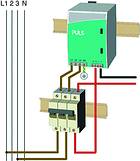
Munich-based power supply specialist, PULS has launched a three-phase, compact 240 W standard power unit (10 A at 24-28 V d.c.) with a number of innovative features, some of which are discussed below.
The unit needs no fuses on the primary or secondary side and provides for unrestricted two-phase use, the switchable control response offers the unique fuse mode in the event of an overload as well as reliable load distribution and stabilisation in parallel mode. PULS says that the unit doesn't cost any more than the corresponding single-phase unit.
Overload behaviour has been one of the focal points of developments by PULS for a number of years. The Munich-based firm recognised that the hiccup mode, in which the power unit temporarily switches off and then attempts a restart at regular intervals every couple of seconds, poses problems in practice: the current surges that occur during the attempted restarts create an unnecessary load on the connected consumers; even more; in drive units they represent a potential injury hazard. Secondly, the short current surges are insufficient to trigger a secondary fuse. And specific loads such as motors, high capacities or the DC/DC converters, which have recently become increasingly more popular, require a significantly oversized power unit with hiccup response to start them. These loads quickly consume twice or more their nominal current for start-up. If the power unit size is geared to the nominal current it is subject to an overload when starting up and normally switches off immediately, consequently these types of loads do not actually get going.
With the PULS-Overload-Design in 1998 in the event of an overload the power unit delivers up to 1,5-1,8 times its nominal current, with the output voltage being reduced as the current increases. This enables even heavy loads to be started-up without the need for costly, oversized units and, if necessary, the user can employ a secondary fuse in order to securely switch off the load in the event of an overload.
Fuse mode saves the need for secondary fuse
For flexibility catering for different user requirements, the overload behaviour can be switched to the 'fuse mode' via a jumper (see Figure 1) which is externally accessible: here, in the event of an overload - ie if the nominal output voltage can no longer be sustained - the unit switches off the output completely after approximately 5 s and displays this status by way of a flashing LED. To reactivate the output either the reset button on the front of the unit has to be pressed or the unit separated from the power supply for about one minute (the delay time is necessary to allow the internal capacitors to discharge).

This fuse mode means that many users now no longer need the secondary fuse - particularly since the electronic fuse operates with considerably greater precision and is therefore easier to calculate (and more reliable) than the standard thermo-magnetic automatic fuses. An additional secondary fuse is only required if the shut-off threshold of approx. 12,5 A or 14 A (at 28 or 24 V and 25°C ambient temperature) is too high for the connected loads or the overload cut-off after 5 s occurs too late. This 5 s delay was selected so that the power unit can also cope with the previously mentioned slower loads. It is only when the current reaches more than 2-3 times the fuse value through an automatic fuse with the fast Z characteristic, that it is actually triggered in fractions of a second.
Three-phase input: continuous two-phase operation permitted
The SL10.300 is also internally fused on the primary side - a rare feature in three-phase units. This means that the unit no longer needs any external fuse on the primary side, this may only be necessary in order to protect the power supply cable or for other parallel loads if these do not have any internal fuses.
The input also permits fully specified two-phase operation, i.e. for the very first time a standard power unit also provides for continuous, unrestricted two-phase operation under full load.
Its 250 W output capacity places the SL10.300 in the medium output range. It lends itself as an all-rounder and can be easily integrated wherever required - thanks to its compact design (W x H x D = 89 x 124 x 117 mm).
It is in parallel mode in particular that the SL10.300 demonstrates strengths that its makers say are a rarity in this output category. The characteristic curve can be switched to be slightly 'softer' (1 V voltage difference between no load and full load) which ensures that all power units switched in parallel evenly distribute the load between them. In the event of a sudden load increase each SL10.300 temporarily takes up its share of the load in the parallel grouping so that even this kind of load surge is evened out immediately and smoothly. Up to five SL10.300s can be connected in parallel in this way, which means that virtually every type of application between 0 and 1250 W throughout the world can be provided with a reliable power supply for years - with only one single power unit model held in stock.

© Technews Publishing (Pty) Ltd | All Rights Reserved